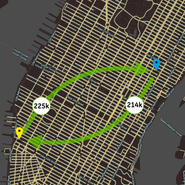- About
- Subscribe Now
- New York,
March 14, 2014

Audi of America is teaming up with MIT and General Electric to track more than 150 million taxi trips in New York to address urban transportation problems.
The "HubCab Project" will sift through data from a transportation tracking tool to uncover commuter patterns for optimizing ride-sharing. The team sees increased ride-sharing as an important step to reducing emissions, congestion and the costs for mobility infrastructure.
"As a leading premium car brand globally, Audi is aggressively investigating technologies that could improve safety, ease emissions and reduce stress that are likely to multiply as the world’s megacities become more congested," said Brad Stertz, corporate communications manager at Audi of America, Herndon, VA.
"Many of these cities are found in key Audi markets," he said.
Pervasive connectivity
The HubCab project is predicated on the idea that digital-connectivity pervades urban life. The majority of people, buildings and vehicles emit signals that can be netted and analyzed for a better understanding of how cities function.
Taxis, for instance, connect with other taxis, dispatchers, locations and payments.
Audi's collaboration with MIT and GE, HubCab
Such data from taxi rides was synthesized to create a living map of taxi movements, led by the MIT Senseable City Lab. The interactive map depicts a year's worth of taxi pickups and drop offs on New York's sprawling grid.
The research team hopes to have citizens interact with the map so that the benefits of sharing taxis are better understood.
HubCab map
Yellow dots that denote taxi pickups and blue dots that denote drop offs stud the streets.
A disk in the upper right corner allows users to select a time of day in three-hour intervals. If the all-year day is selected, the streets become bloated with dots.
Zoomed-in view of midtown streets with all-year round selected
A yellow pickup marker and a blue drop off marker can be dragged to points on the map to calculate data.
For instance, after placing the pickup marker on East 49th Street, Park Avenue and the drop off market on West 55th Street, 9th Avenue, selecting 9 a.m. - 12 p.m. and choosing a pickup radius of a 1/4 mile, the following data appears:
1) 1,433 total pickups at East 49th with an average trip duration of 11.5 minutes and an average distance traveled of 2.67 miles. While traveling to 9th Avenue, 841 people could have been picked up.
2) 940 total drop offs on 9th Avenue with an average duration of 10.2 minutes and an average distance of 2.26 miles. While traveling to East 49th, 864 people could have been picked up.
3) Had the maximum amount of ride-sharing taken place, $6,262, 1,687 miles and 713 kilograms of CO2 would have been saved.
HubCab map
Ultimately, HubCab plans to help people see who else is looking for a cab in the vicinity so that he or she can be picked up on the way, thus reducing the number of cabs roving, money spent and CO2 emitted.
Researchers are studying the data to determine when sharing a ride makes sense in terms of money saved, CO2 released and less congested streets.
The team will work on optimizing the transportation infrastructure and atmosphere in general.
Audi also plans on using real-time urban data to develop connected car technologies that reduce congestion, improve safety and make urban driving less stressful, according to the brand.
Data such as local vehicle and pedestrian information can be sourced from HubCab.
The HubCab project team was led by Carlo Ratti, director of the Senseable City Lab at the Massachusetts Institute of Technology, which is sponsored by ERL and General Electric. Ratti is a member of the World Economic Forum's Global Agenda Council for Urban Management.
Meeting challenges
Audi consistently embarks on projects that aim to unravel urban challenges.
For instance, Audi continued to grapple with pressing global issues through its Urban Future Initiative Award 2014 that commenced Jan. 6, the evening before the opening of the International CES in Las Vegas.
Fans voted until Jan. 5 between three speed pitches by United States teams vying to take part in this year’s urban future initiative. Philip Parsons, urban planner and founder of Sasaki Strategies, and Federico Parolotto, mobility expert and principal of Mobility in Chain received the most votes for their “New online marketplace for mobility” proposal and will be given the opportunity to flesh out their ideas until October (see story).
Also, Audi enlisted 12 United States undergraduates for a six-week practicum in the summer of 2014 to investigate how mobility will evolve in the coming decades.
Major cities around the world are experiencing increasing population density that place a strain on public and private resources, especially transportation. The U.S. undergraduates will explore ideas that address how automobiles will adapt to the stressed infrastructure and shifting availability of resources (see story).
However, a project with such ambitious dimensions will take many years to harness.
"Understanding the available data is a crucial first step," Mr. Stertz said. "Developing the engineering ideas that respond to that data is a longer-term proposition."
Final Take
Joe McCarthy, editorial assistant on Luxury Daily, New York
Share your thoughts. Click here